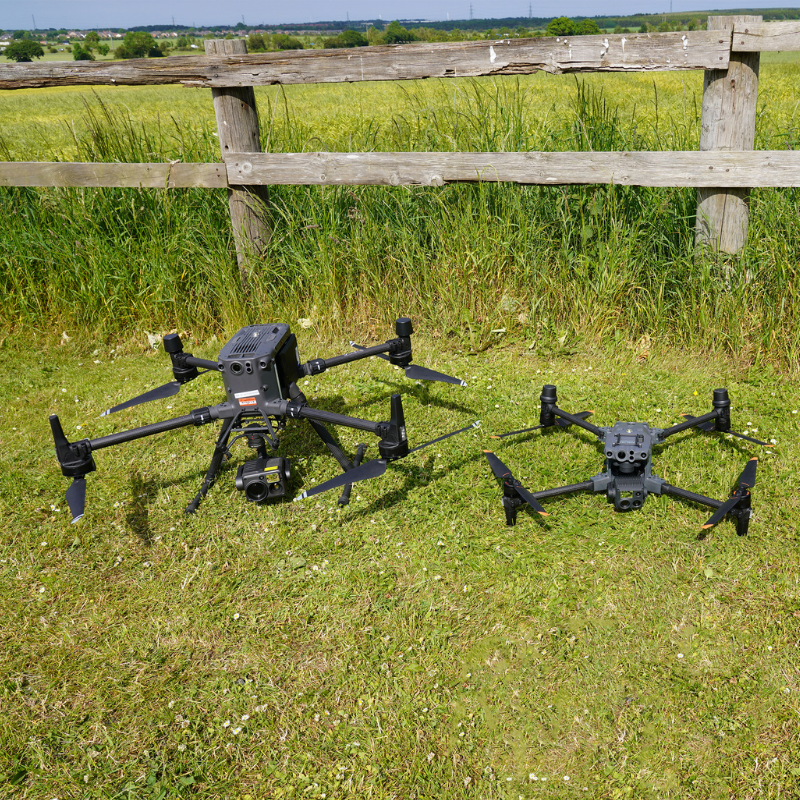
Products
Side-by-side Camera Comparison: DJI M30T vs DJI M300 RTK & H20T
Explore its camera quality, zoom, and thermal performance for inspections and search & rescue.

Sample data sets show the difference between the camera on the DJI M30T and the H20T for the DJI M300 RTK;
Tests conducted on a powerline, in a search and rescue scenario, and number plate recognition;
Data sets indicate the H20T has the edge on visual data, especially at further distances;
Both performed well in the search and rescue test: The thermal sensors detected the heat source of the 'missing person' and the controller's side-by-side view (thermal and visual) proved an effective search and rescue tool;
DJI M30 Series is more lightweight, portable and cost-effective and has enhanced IP protection; The M300 RTK is a heavy duty drone which is more versatile with interchangeable payloads, including mapping payloads;
Use this test to help you decide which drone is ideal for your specific operations.
The DJI M300 RTK and H20T or the DJI M30T: Which is best for data collection?
To find out, we took both to our official flight field to test their visual and thermal cameras, putting them through a number of tests and then comparing the outputs side by side - as shown in this blog. The tests were:
Powerline: Zoom test, flying at different distances (20m to 100m) from the pylon. We also engaged the thermal camera.
Search and Rescue: The drones' ability to find a missing person in a field. The zoom and thermal were tested, including the side-by-side screen display showing the visual and infrared data.
Number Plate: The distance at which the drones could clearly detect a car number plate.

All data sets shown in this blog are the original files (in JPEG format) and have not been enhanced in any way. For the purposes of data security, two digits from the car number plate - belonging to a heliguy™ employee - have been photoshopped out.
The camera settings were kept the same for both drones: On Auto, and the EV settings at zero. The tests were conducted on the same day (dry, hot, cloudy intervals), but staggered by about 20 minutes, so subtle weather changes were possible.
DJI M30T Vs DJI M300 RTK: Camera And Platform Specs
Before we delve into the visuals, let's first compare the cameras.
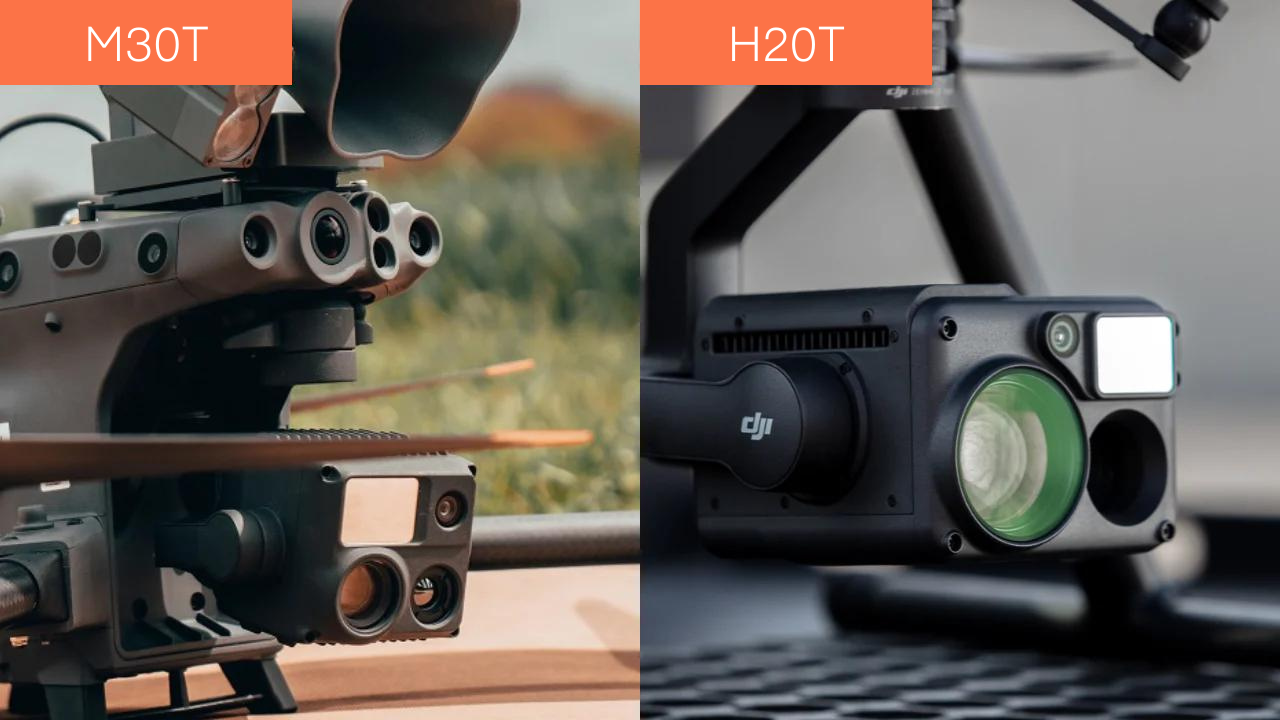
In both cases, the cameras have wide, zoom, and laser rangefinder capabilities, as well as a thermal sensor (hence the T at the end of the names). The payload is fixed to the M30 Series, whereas the H20T can be removed from the M300 RTK.
The table below shows the capabilities of the H20T and the sensor on the M30T.
M30T | H20T | |
Wide Angle | Equivalent Focal Length: 24 mm, DFOV: 84°; 12 MP 1/2'' CMOS Sensor; Video Resolution: 4K/30fps | Equivalent Focal Length: 24mm, DFOV: 82.9°; 12 MP 1/2.3” CMOS Sensor; Video Resolution: 1080@30fps |
Zoom | 48 MP 1/2'' CMOS Sensor; Up to 16x Optical Zoom, 200x Max. Hybrid Zoom; Video Resolution: 4K/30fps | 20 MP 1/1.7” CMOS Sensor; Up to 23x Hybrid Optical Zoom, 200x Max Zoom; Video Resolution: 4K/30fps |
Laser Rangefinder | Range: 3 m - 1200 m; Accuracy: ±(0.2m+D×0.15%) | Range: 3 m - 1200 m; Accuracy: ± (0.2 m + D×0.15%) |
Thermal | Resolution: 640 x 512; Infrared Image Super-resolution Mode: 1280 x 1024 Frame Rate: 30fps | Resolution: 640 x 512; Frame Rate: 30fps |
Alternative versions - the H20 camera and M30 drone - do not come with thermal.
As well as the cameras, it is important to give an overview of the two platforms. Note how the M30T is smaller, lighter, has enhanced IP rating, and is more cost-effective, while the M300 RTK is more versatile, with interchangeable payloads - including surveying cameras - and the ability to carry up to three payloads at once.
M30T | M300 RTK | |
Weight | 3.77 kg (including two batteries) | M300 RTK: Approx. 6.3 kg (with two TB60 batteries) H20T: 828G |
Dimensions (L x W x H) | Unfolded (propellers excluded): 470 x 585 x 215 mm Folded: 365 x 215 x 195 mm | Unfolded (propellers excluded): 810 x 670 x 430 mm Folded (propellers included): 430 x 420 x 430 mm |
Maximum Flight Time | 41 mins | 43 mins (with H20T) |
Wind Speed Resistance | 15 m/s | 15 m/s |
IP Rating | IP55 | IP45 |
Operating Temperature | -20°C to 50°C | -20°C to 50°C |
Max Transmission Distance (CE) | 8 km | 8 km |
Controller | RC Plus 7.02-inch screen 1,200 cd/m2 brightness IP54 | Smart Controller Enterprise 5.5-inch screen 1,000 cd/m2 brightness No IP rating |
Payload | Fixed Drone compatible with additional modules, such as LP12 loud speaker/spotlight | Removeable/interchangeable/carry up to three at once Drone compatible with H20 Series, including H20N night vision; L1 LiDAR, P1 photogrammetry; XT2; Z30; plus a range of third-party payloads like spotlights, speakers, agricultural sensors, and gas detection modules, among others |
Price | %% price:'dji-m30t-drone' %% | M300 RTK: %% price:'dji-matrice-300-drone' %% H20T: %% price:'zenmuse-h20t-thermal-camera' %% |
Test 1: Powerline - Visual Data
So, how do these drones compare when it comes to inspection missions, such as conducting asset monitoring of powerlines?
For this test, we flew the drones at distances ranging from 20m to 100m, while maintaining a height above the surface of 20m.
We tested the optical and digital zoom on the cameras. Some examples show direct comparisons of zoom level, but in other cases, the cameras have different levels of zoom: For instance, the M30T has a maximum 16x optical zoom, while the H20T has a 23x hybrid optical zoom.
In cases where the data sets are the same, we will show the images individually and then repeat them in a side-by-side comparison. If viewing on mobile, double click the image to enlarge them.
20m away
This is the view of the powerline from 20m.
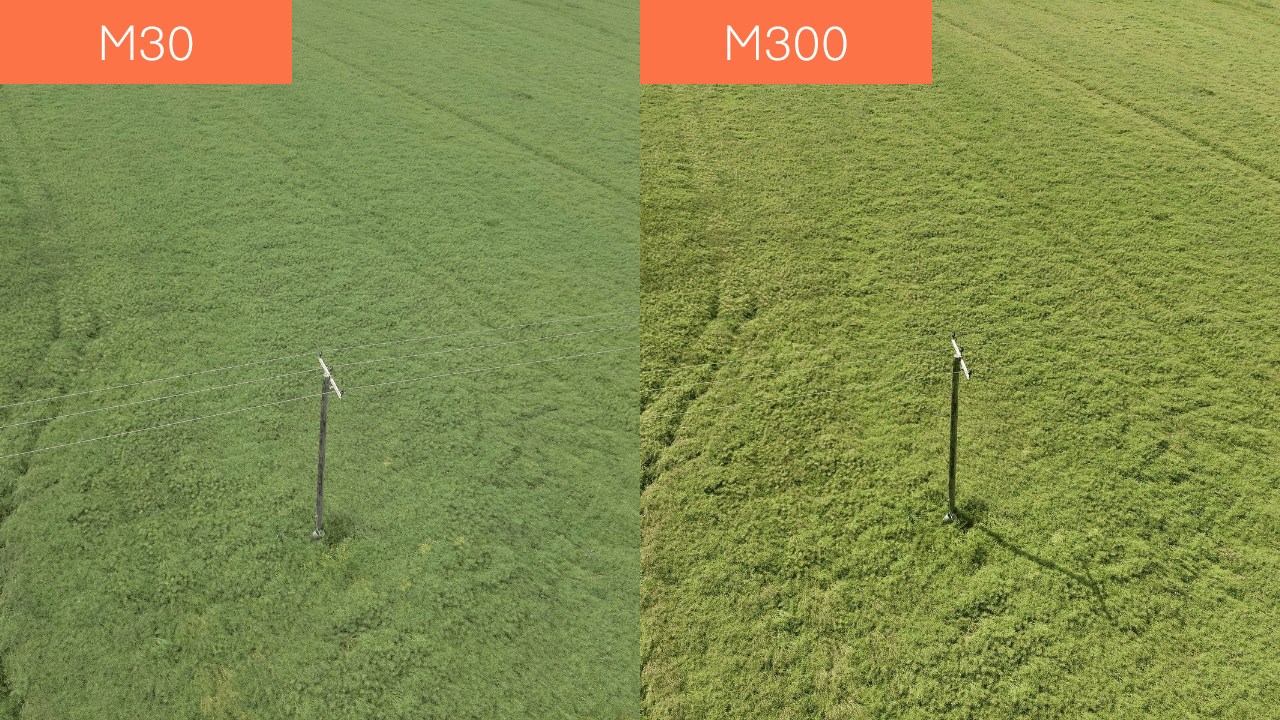
And then we zoomed in:
5x Optical Zoom from 20 metres: M30T and M300 RTK
**
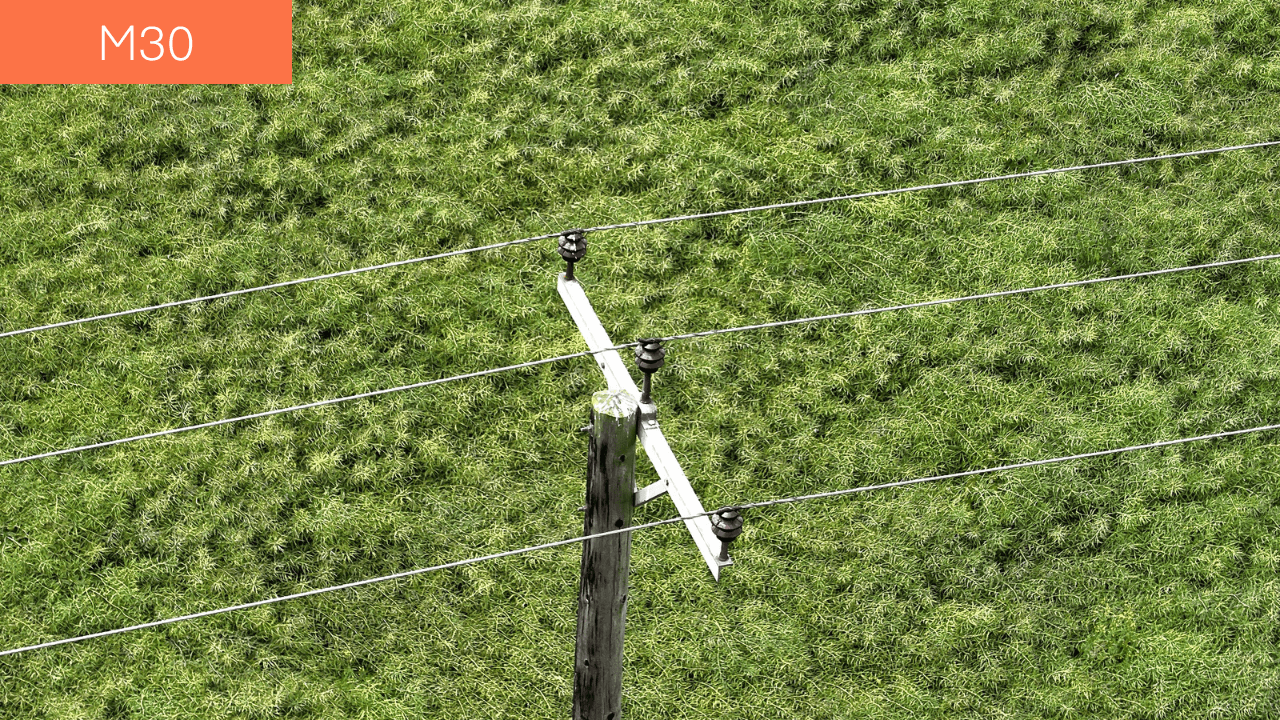
**
**

**
**

**
16x Optical Zoom from 20 metres: M30T

20x Optical Zoom from 20 metres: M300 RTK

40x Zoom from 20 metres: M300 RTK
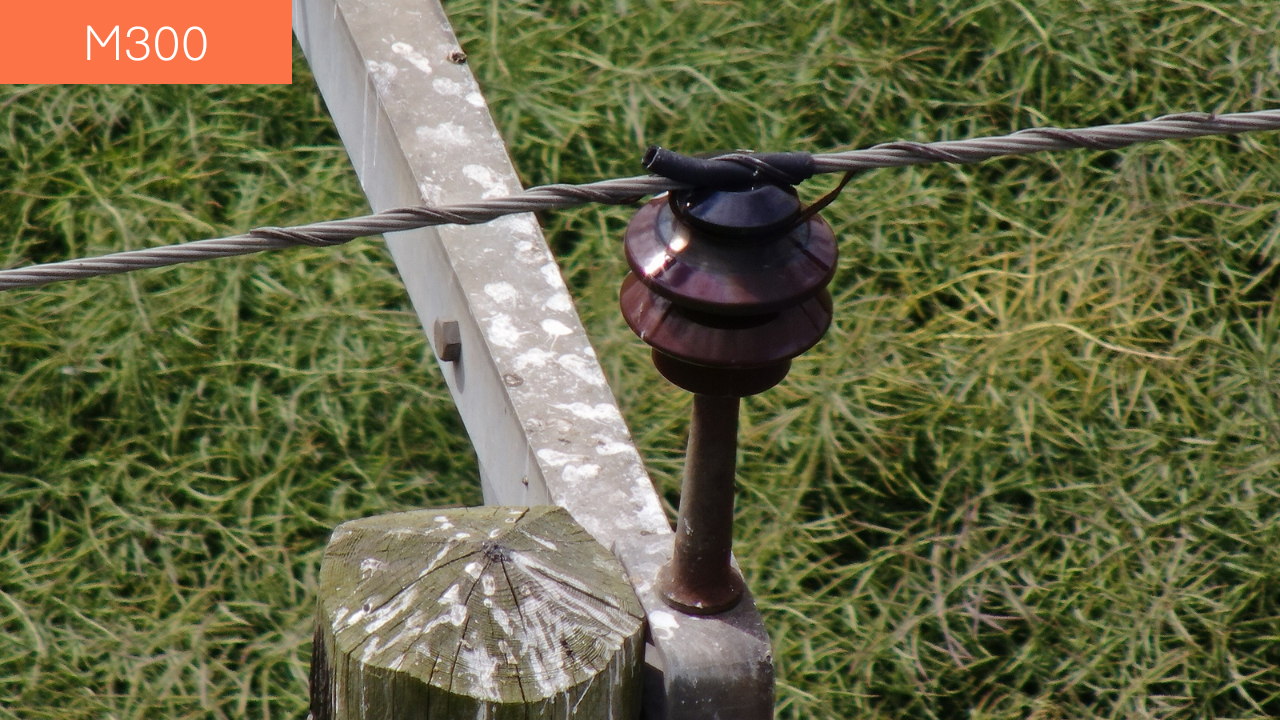
48x Zoom from 20 metres: M30T
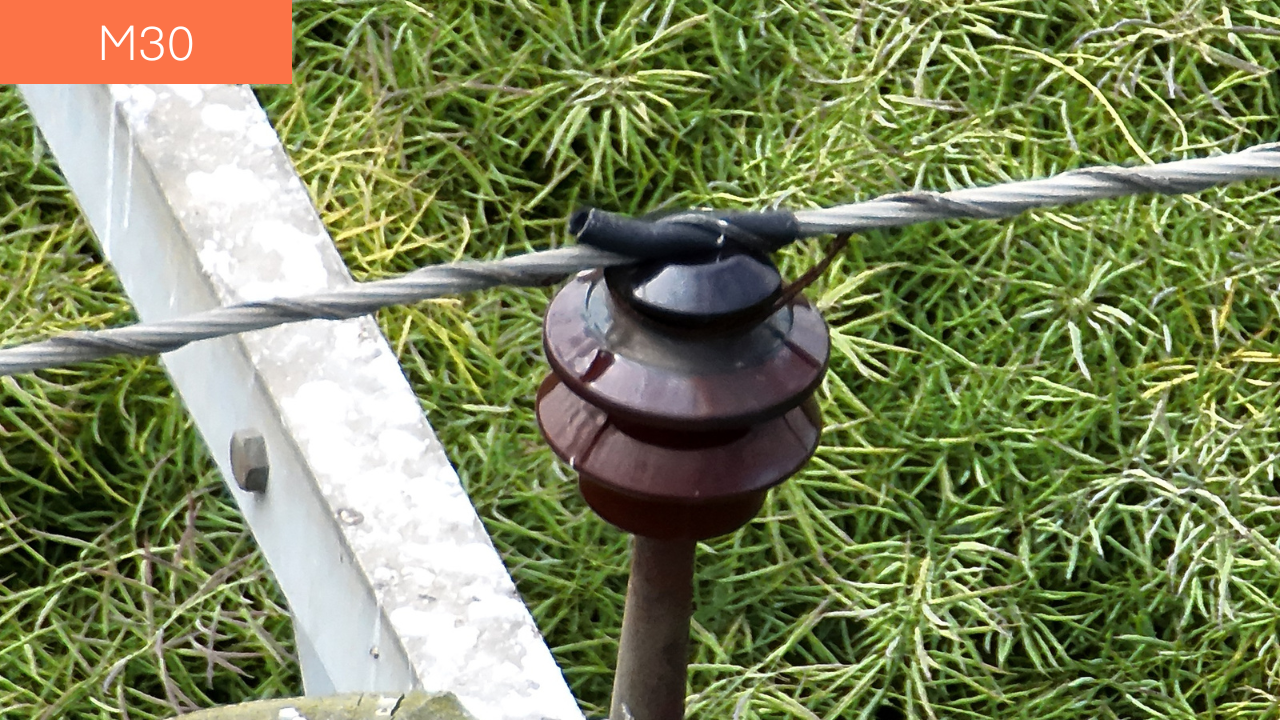
80x Zoom from 20 metres: M30T and M300 RTK
**

**

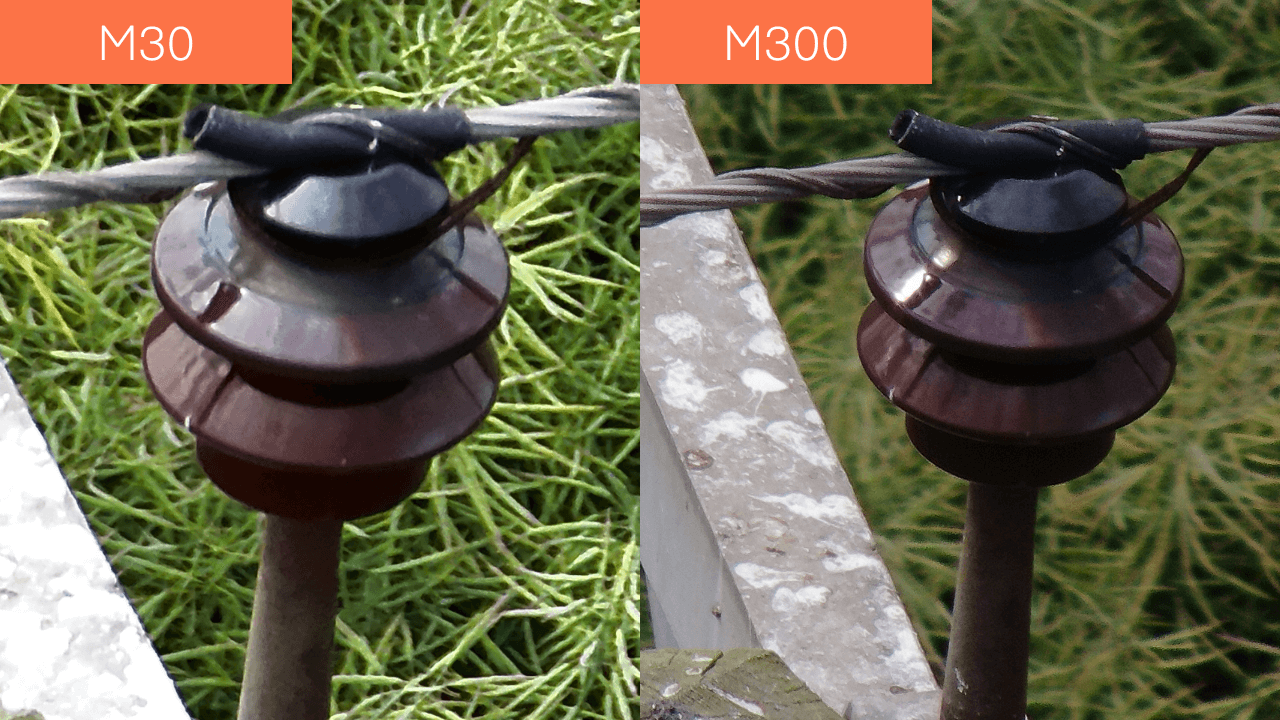
40m away
This is the view of the powerline from 40m away.
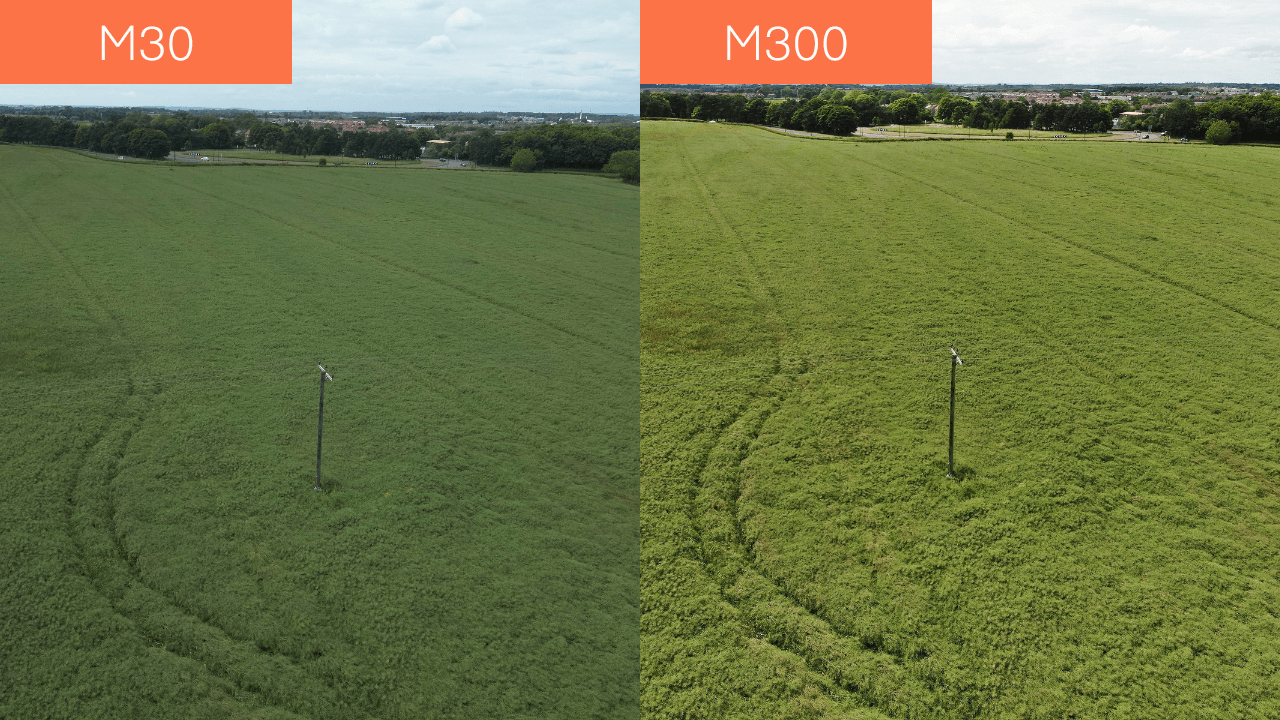
And then we zoom in:
10x Optical Zoom from 40 metres: M30T and M300 RTK



40x Zoom from 40 metres: M300 RTK
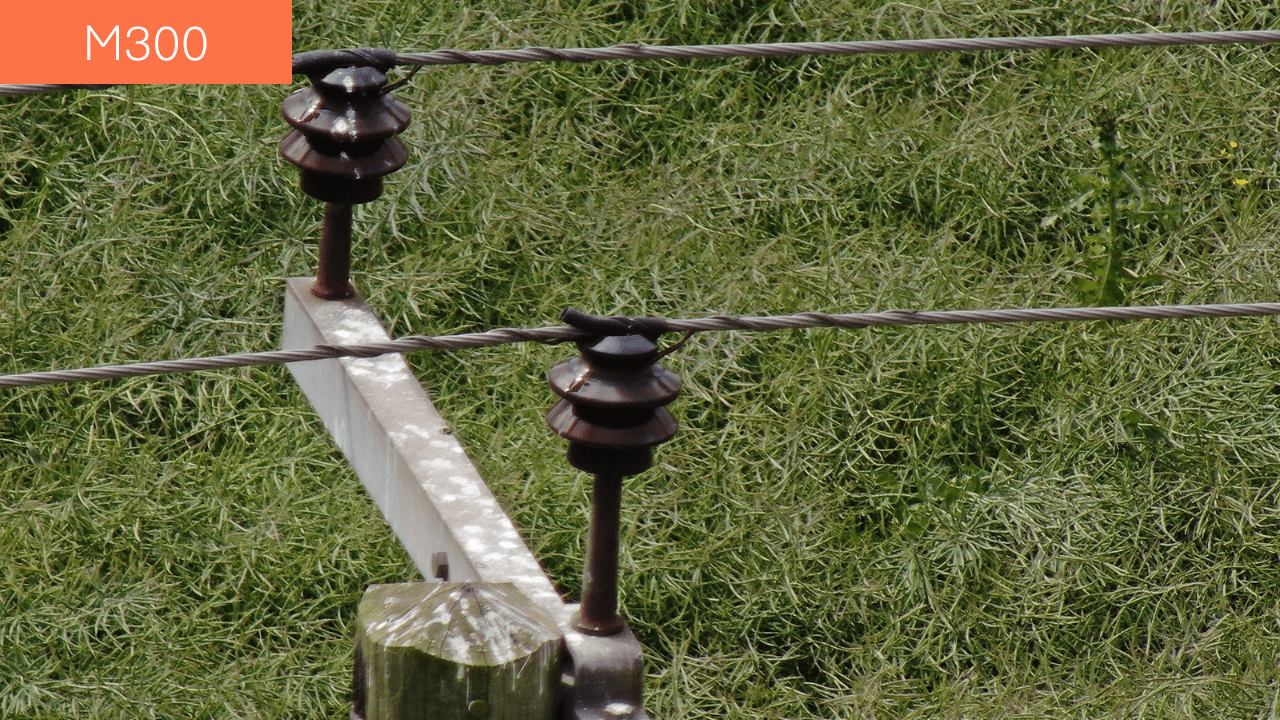
48x Zoom from 40 metres: M30T

80x zoom from 40 metres: M30T and M300 RTK

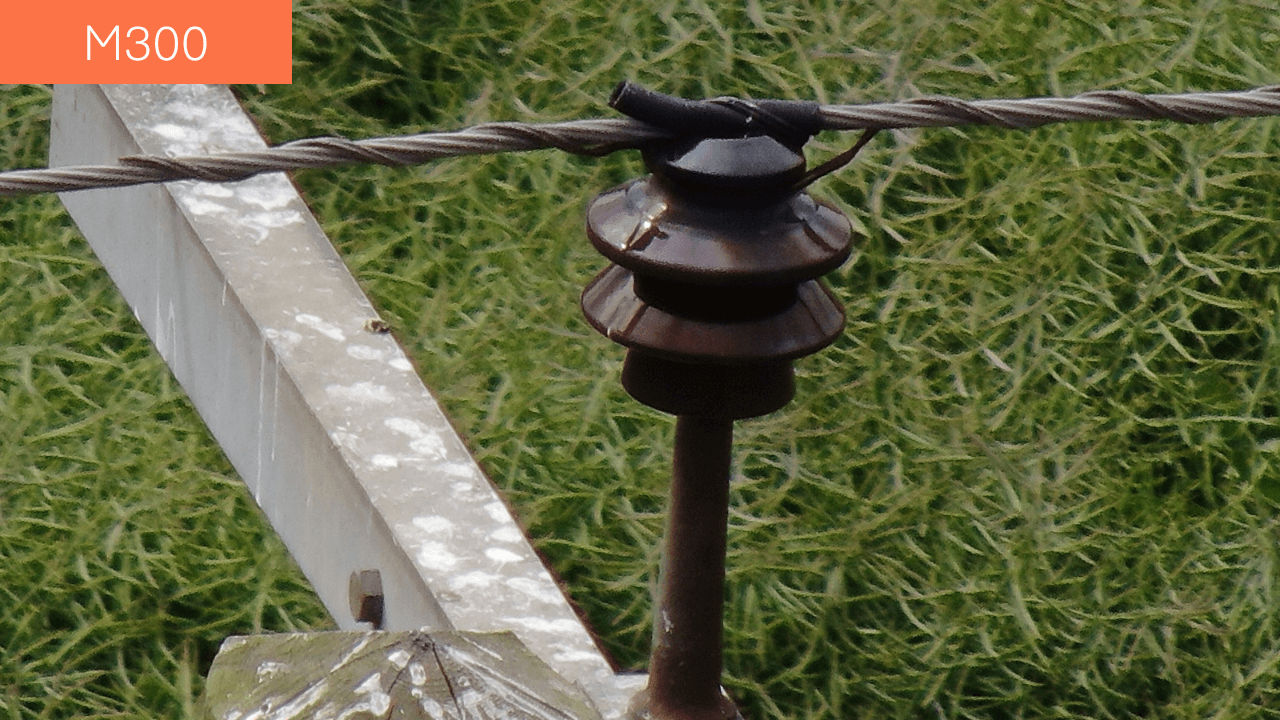

100m Away
We then took the drones to 100m away from the powerline. This is the view of the pylon from 100m.

We then zoomed in:
80x zoom from 100 metres: M30T and M300 RTK


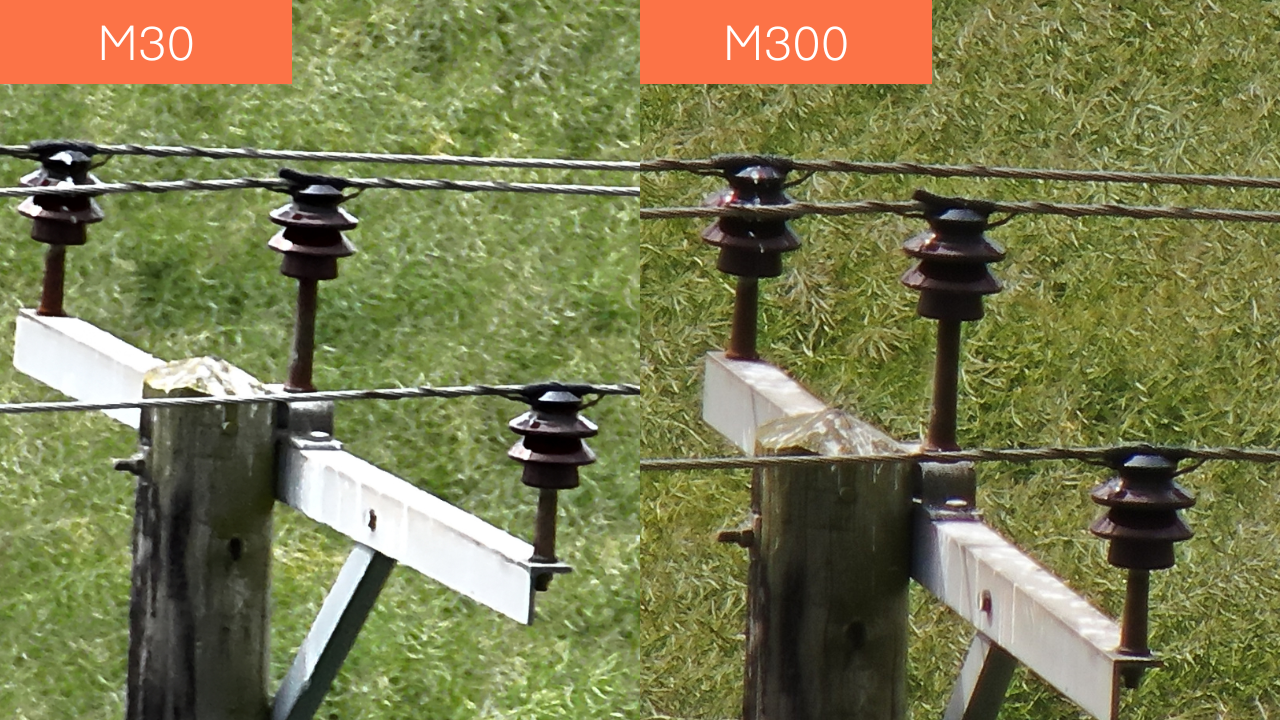
200x Maximum Zoom from 100 metres: M30T and M300 RTK
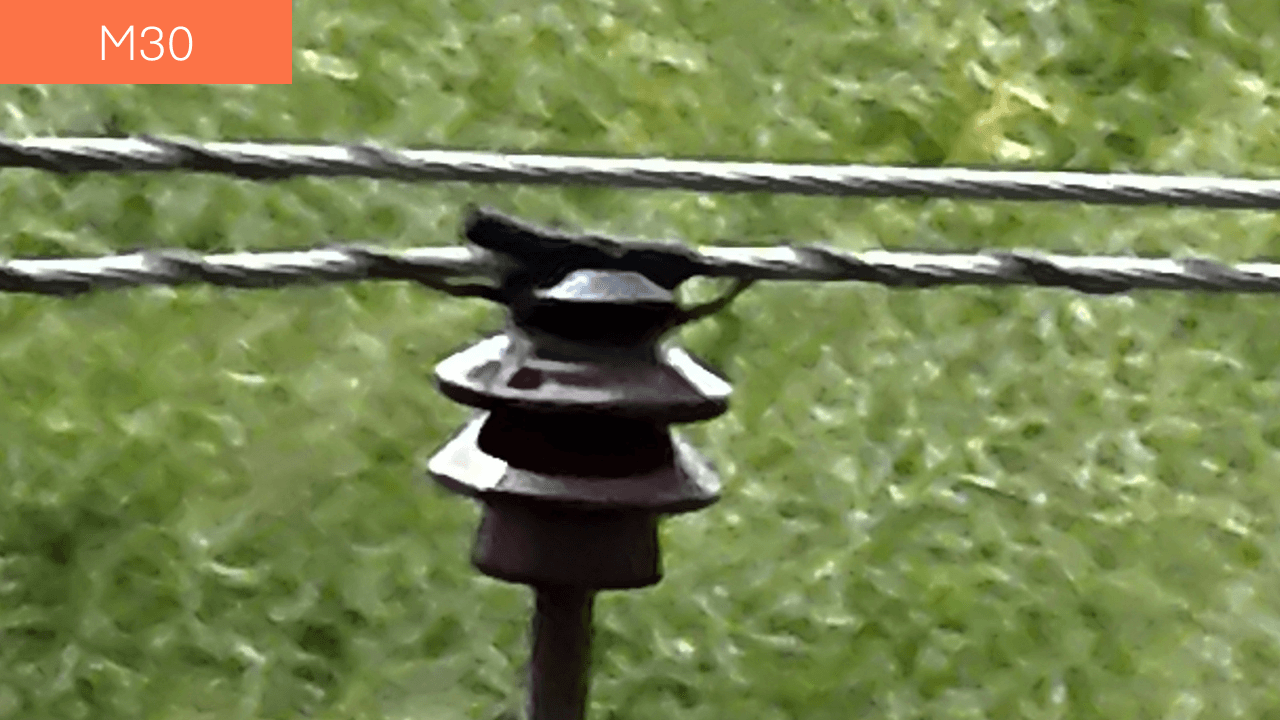
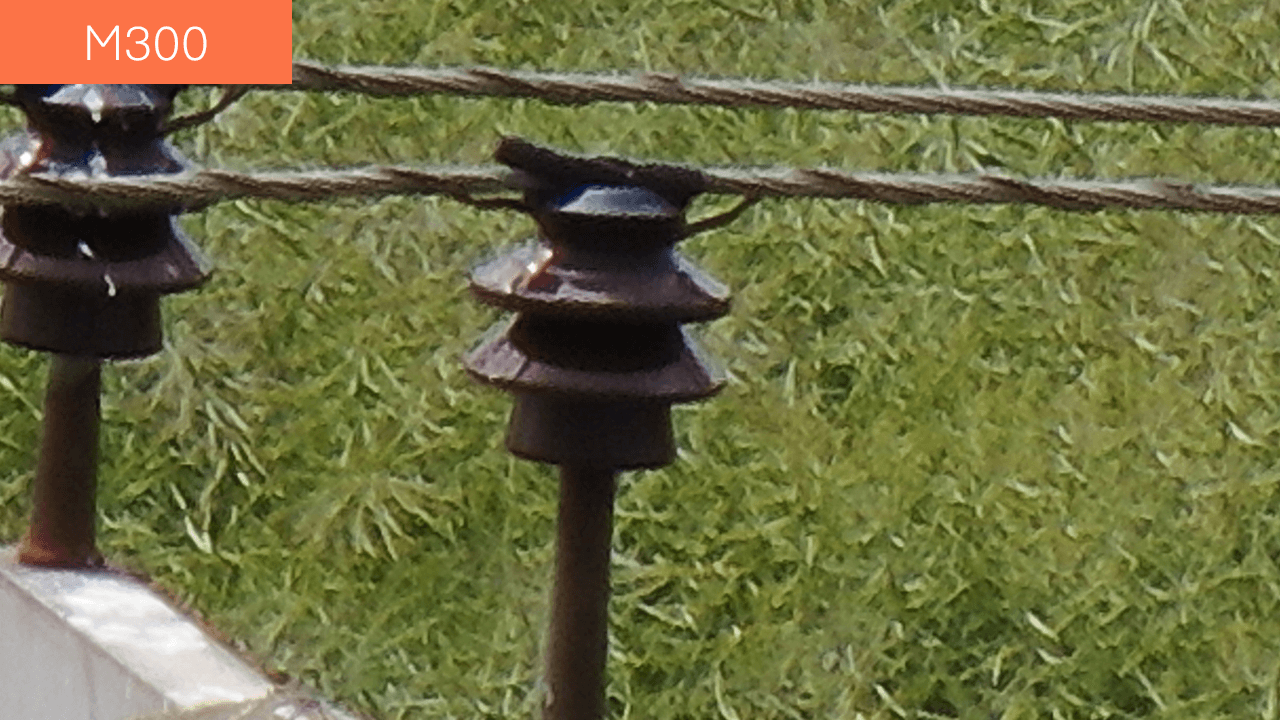

Test 2: Powerline - Thermal
For the next test, we collected thermal data from the cameras. The images below are captured from 20m away from the powerline, and at 20m above the surface.
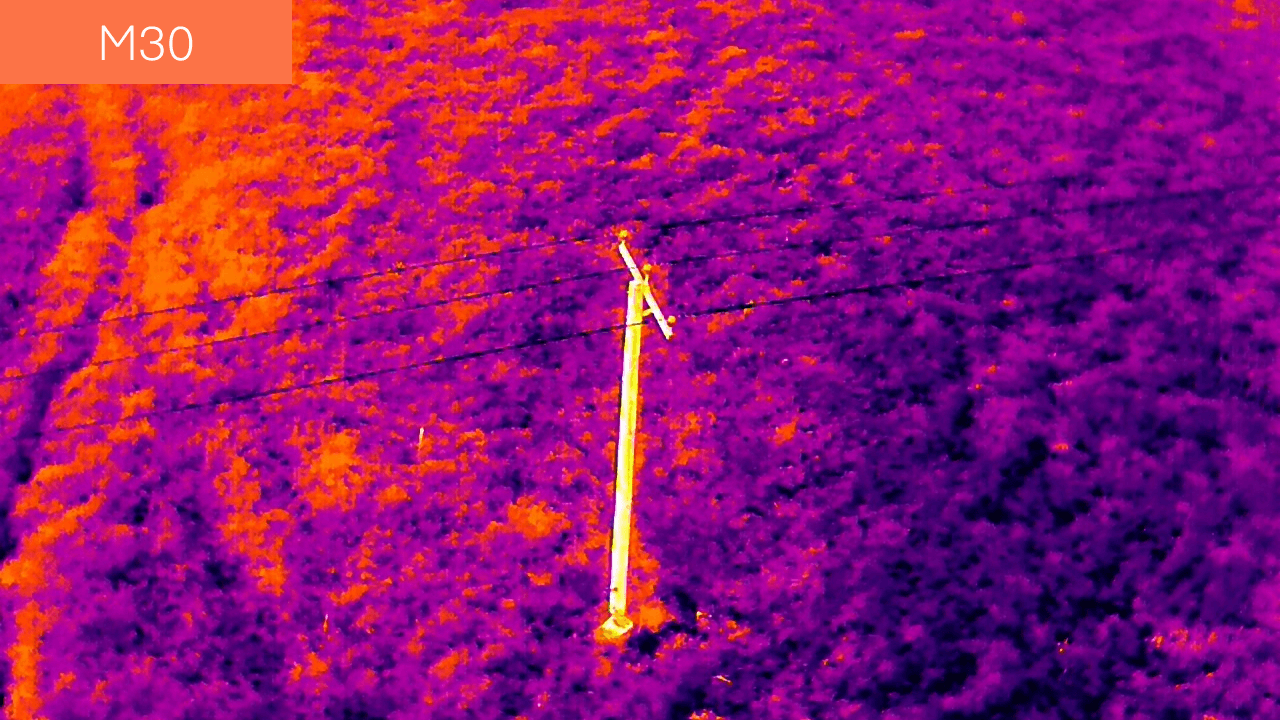

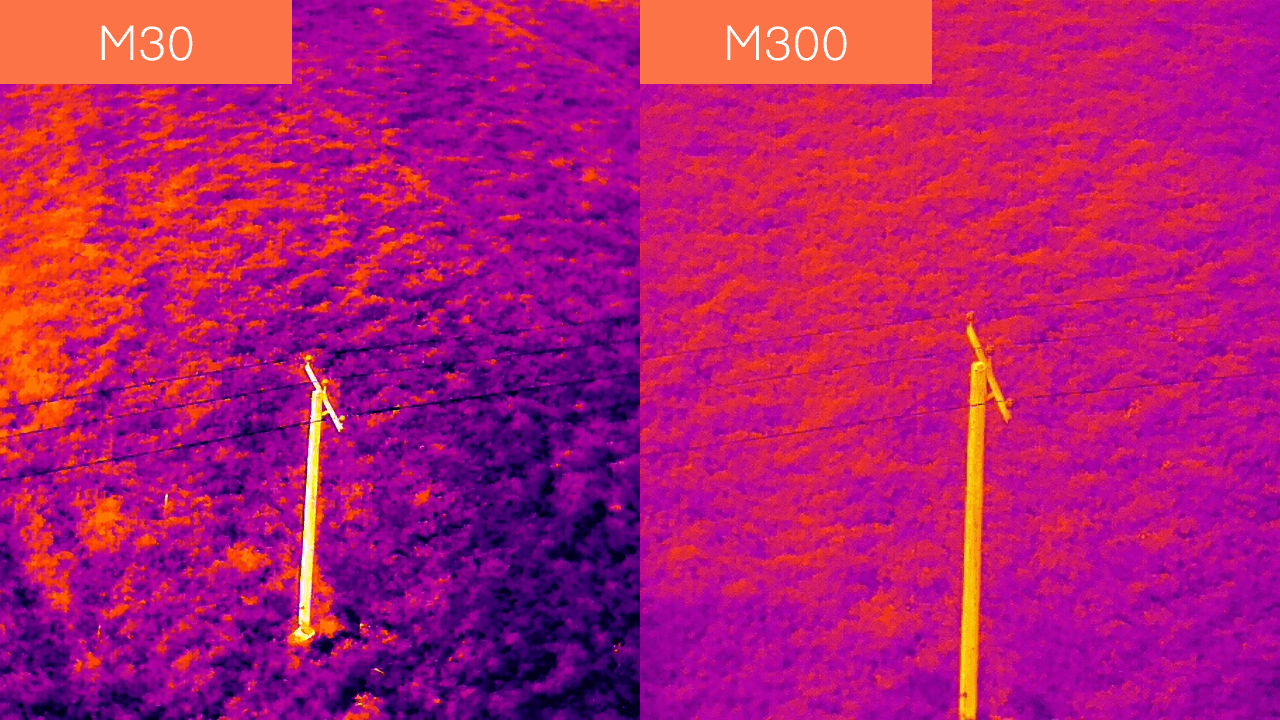
Test 3: Search And Rescue
For the third test, we deployed the drones in a search and rescue scenario, with our subject hiding in some long grass.
We initially positioned the drones 100m away from our 'missing person' and at 20m above the surface.
These were the results:
M30T: 100m Away
In the visual image, the missing person - depicted by the orange circle - is not noticeable...

...but the thermal detects a heat source. While it is a blur, the heat signature is clear, with the yellow/orange hue showing in the sea of purple...

...and this image shows how we deployed the side by side thermal (10x, digitally enhanced) and visual (24x) zoom to clearly identify our subject.

M300 RTK: 100m Away
In the visual image, the missing person - depicted by the orange circle - is barely noticeable...
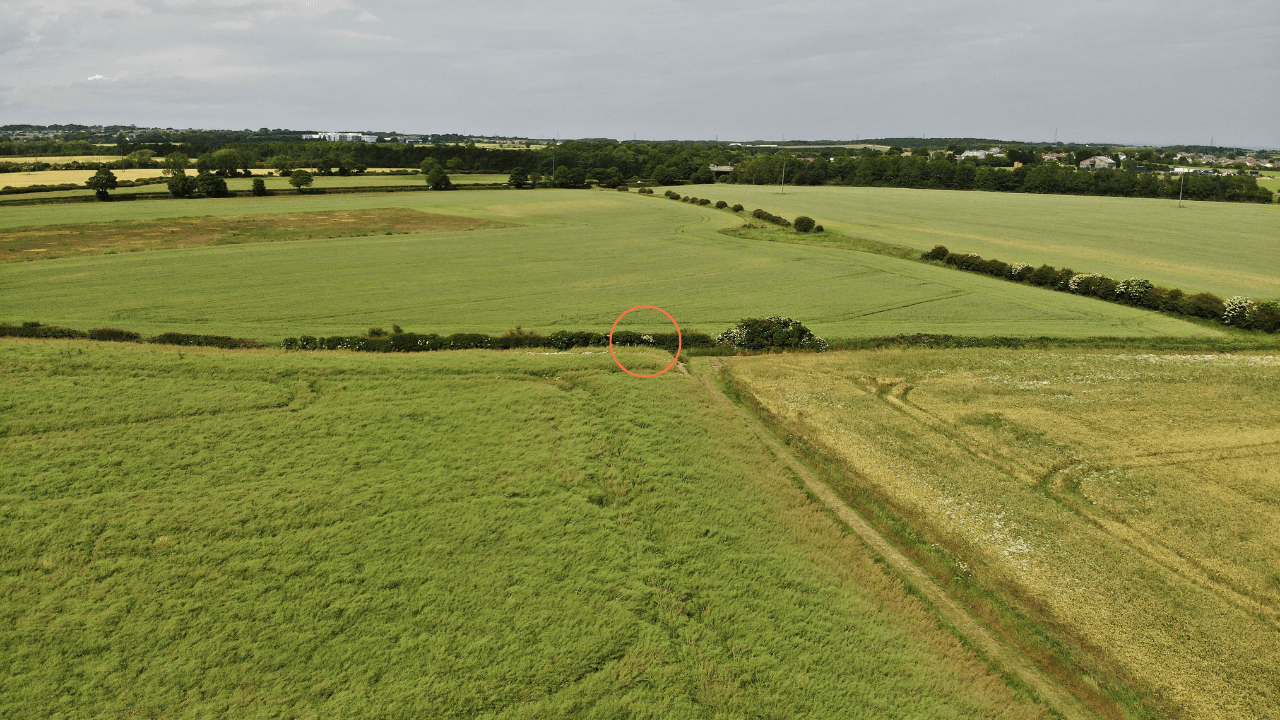
...but in the thermal palette - albeit a different palette to the M30T test - the heat source becomes apparent...
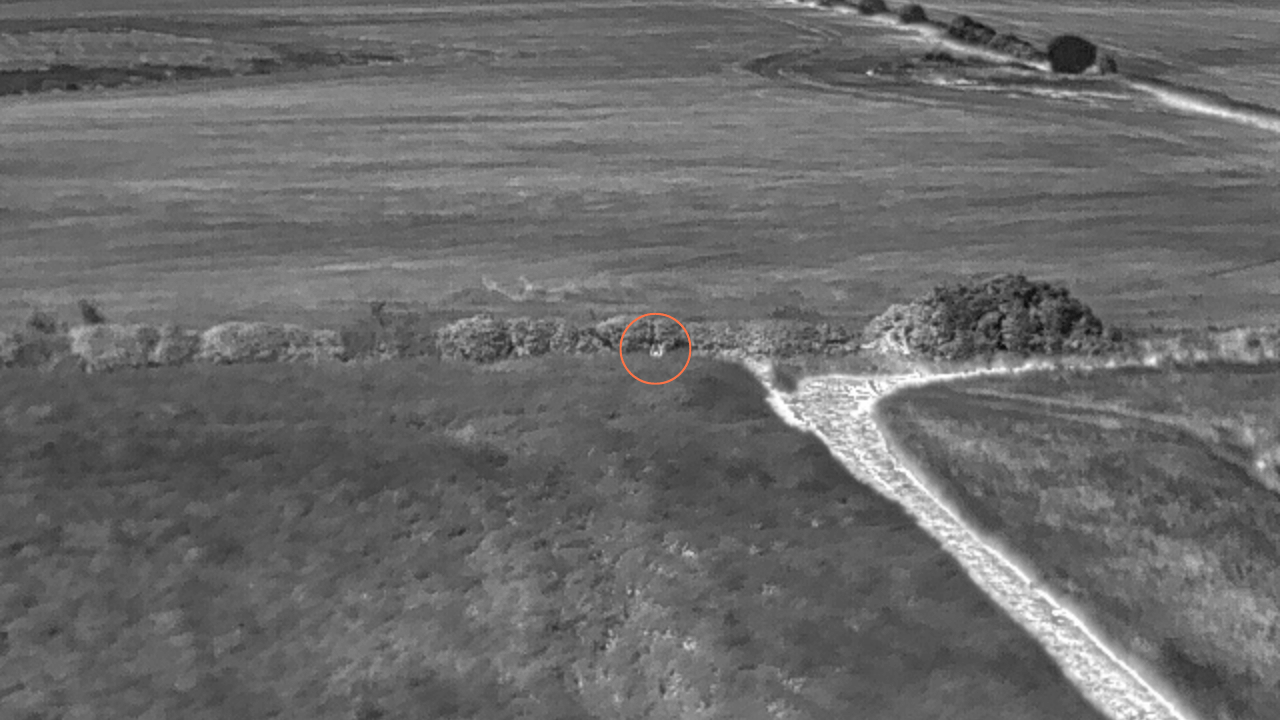
...we then engaged the side-by-side view, zooming in on the visual image...
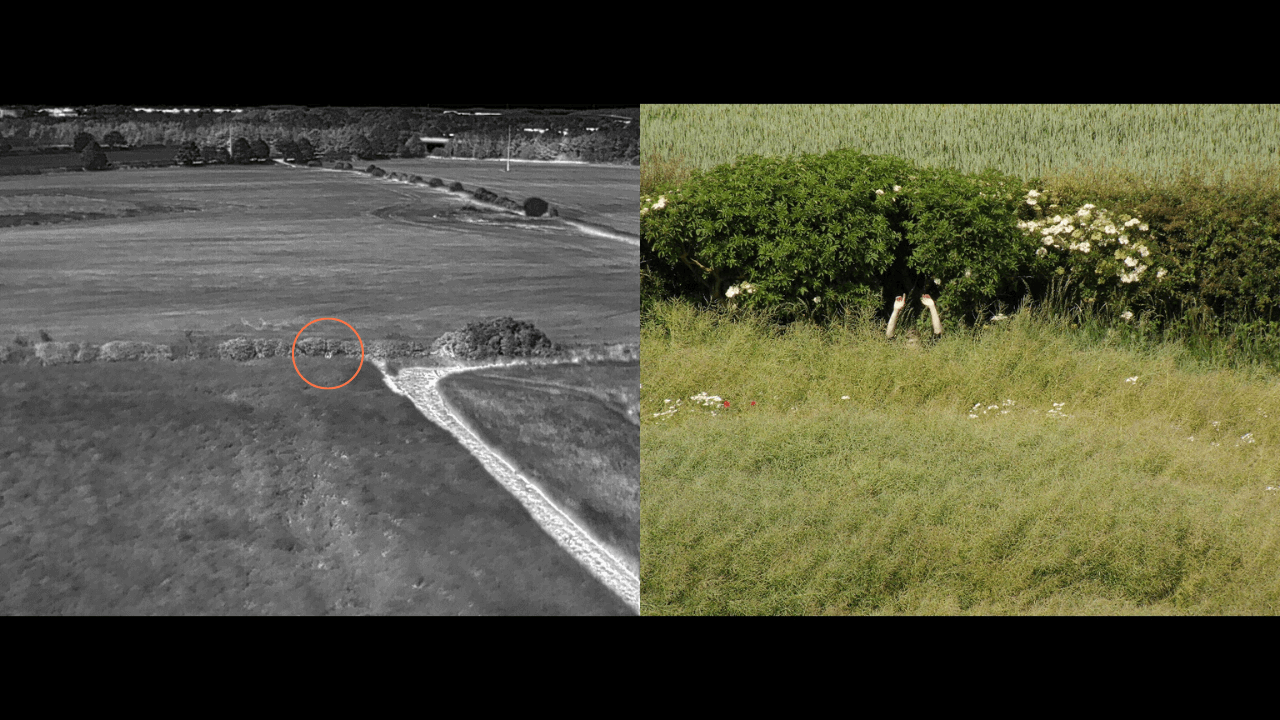
...and finally engaged by zooms, utilising 20x optical and 8x infrared.

200m Away, 60m Height Above Surface
We then took both drones further out, flying them to 200m away from the subject and increasing the height above the surface to 60m.
These were the results:
M30T: 200m Away
The target is extremely hard to identify from this image...

...but the thermal palette does pick up the heat spot. While it is not as clear as the previous flight, there is definitely a signature there...

...and utilising the side-by-side camera, engaging the 32x visual zoom, the subject is identified.

M300 RTK: 200m Away
The missing person is barely visible...
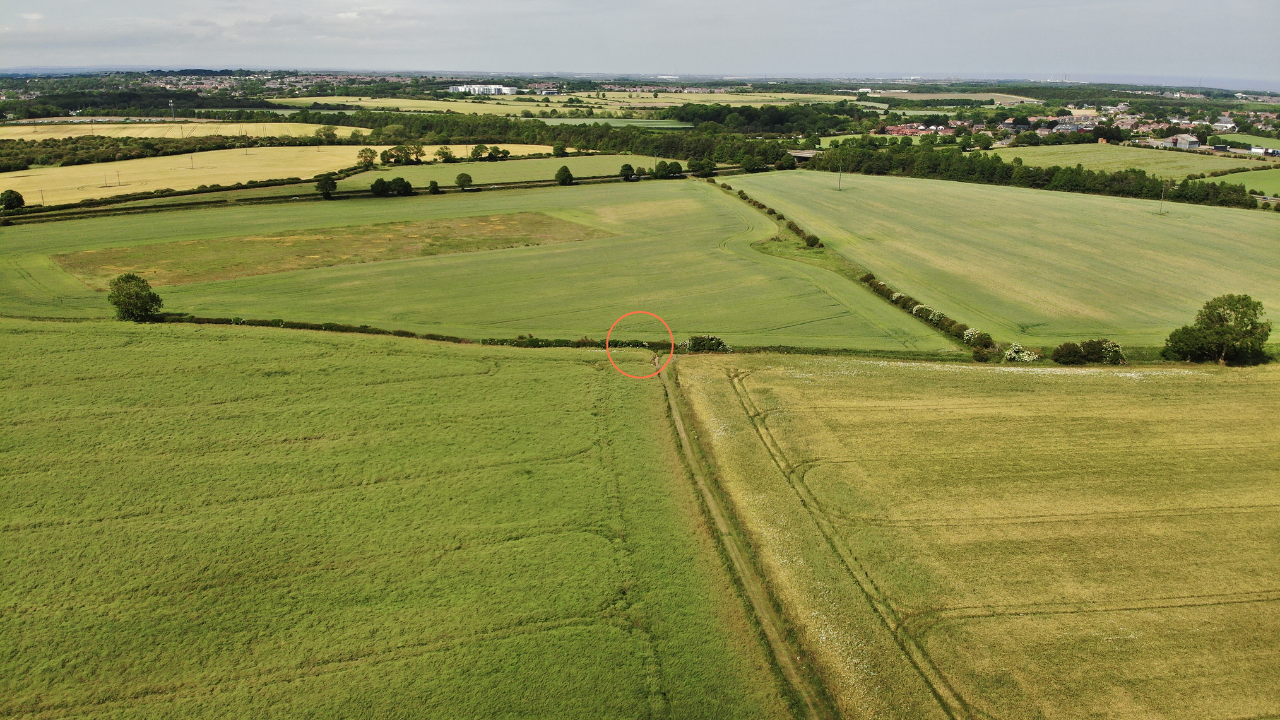
...the thermal - at 8x zoom is blurry - but does show a yellow heat signature, with the side-by-side visual at 20x zoom bringing the subject into focus...
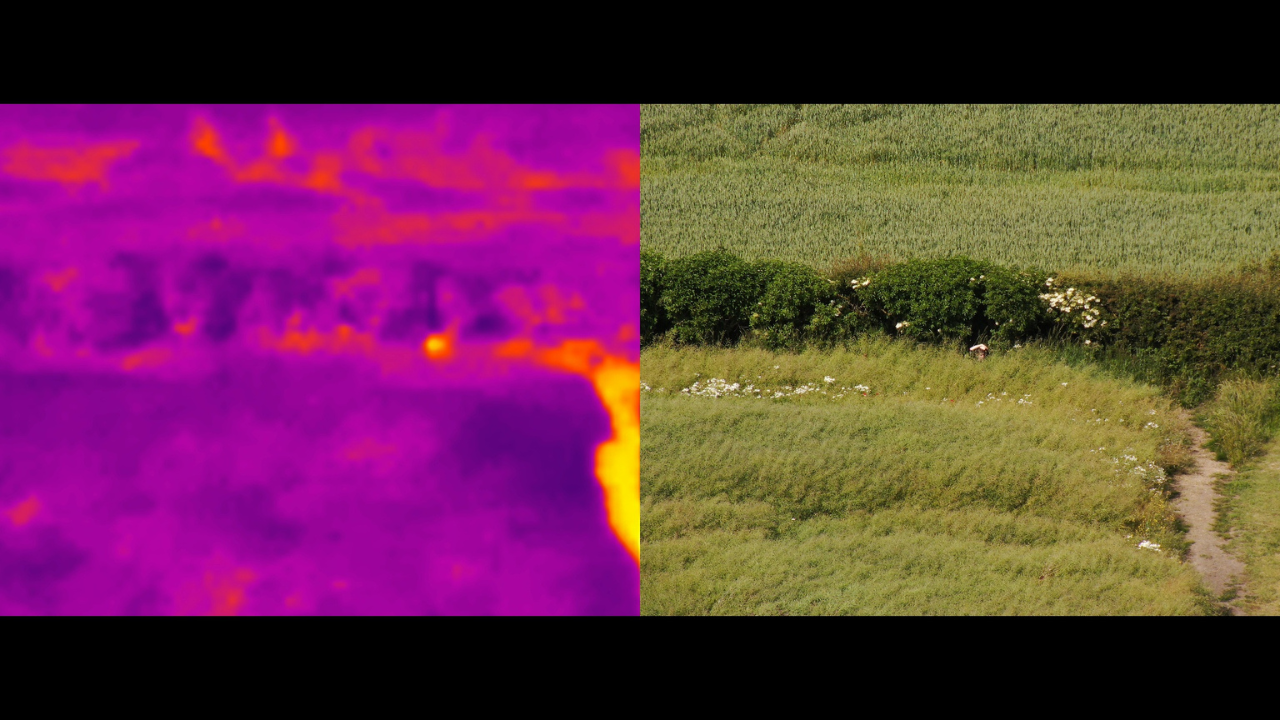
...and this image at 40x zoom clearly identifies our 'missing person'.
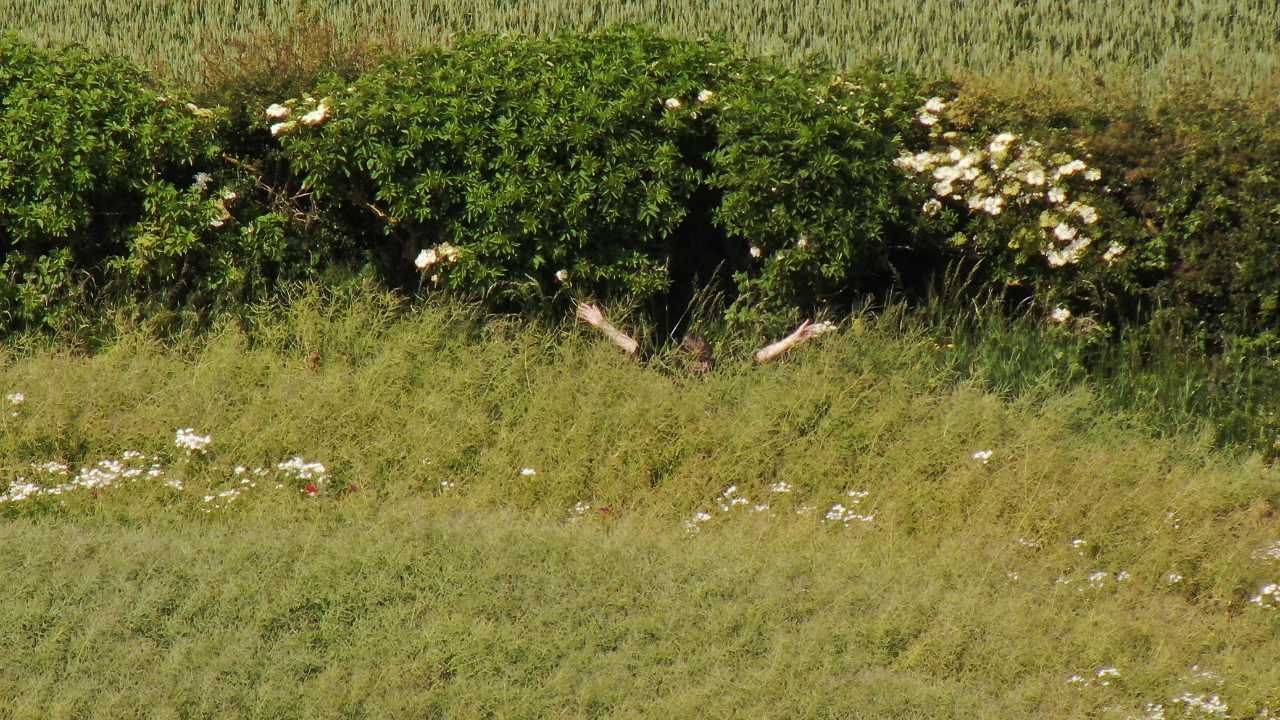
Test 4: Car Number Plate Test
For our final test, we flew the M30T and M300 RTK at various distances from a car to see how their cameras coped with number-plate recognition.
We flew both drones 200m and 300m away from the vehicle, at 60m above ground. As you will see, the M300 RTK-H20T coped better with this test, so we also took the M300 to 400m away from the vehicle.
200m Away From The Subject
This is the view from 200m away. The car is highlighted by the orange circle.

200m Away, 56x Zoom: M30T

200m Away, 60x zoom: M300 RTK

300m Away From The Subject
This is the view from 300m away. The car is very difficult to see in the distance.
**

**
300m Away, 96x zoom: M30T
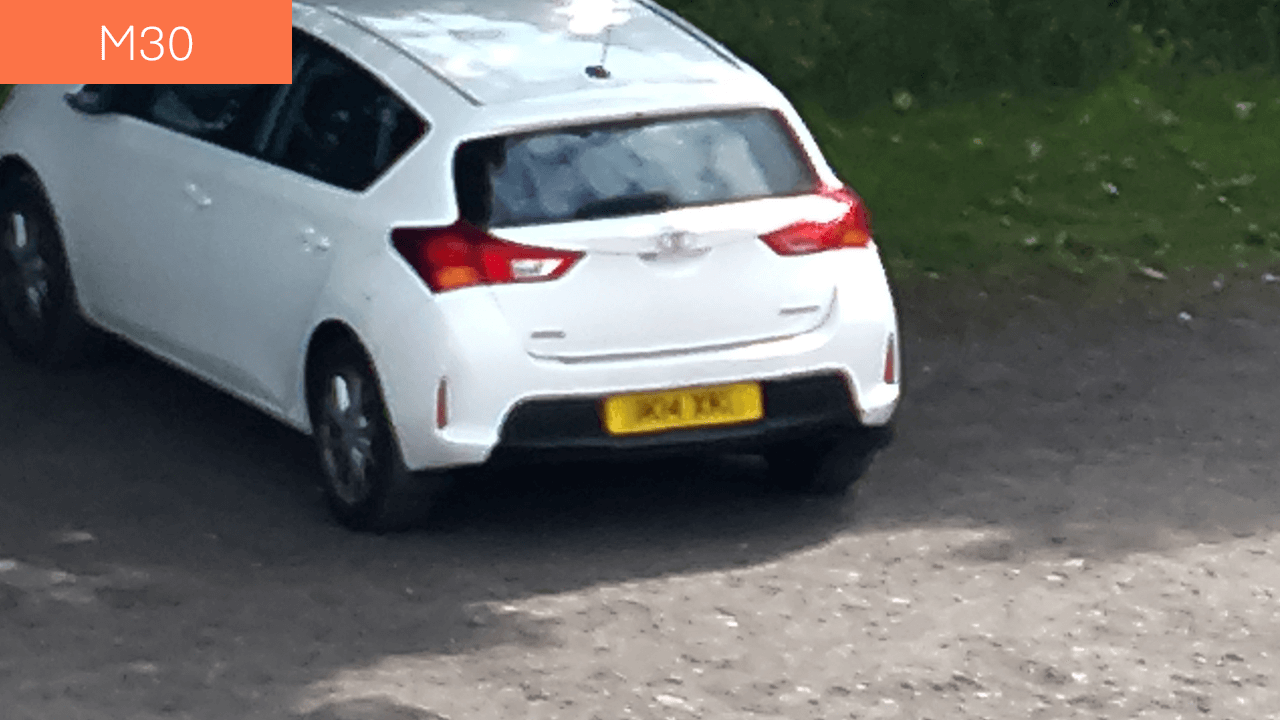
300m Away, 160x zoom: M300 RTK
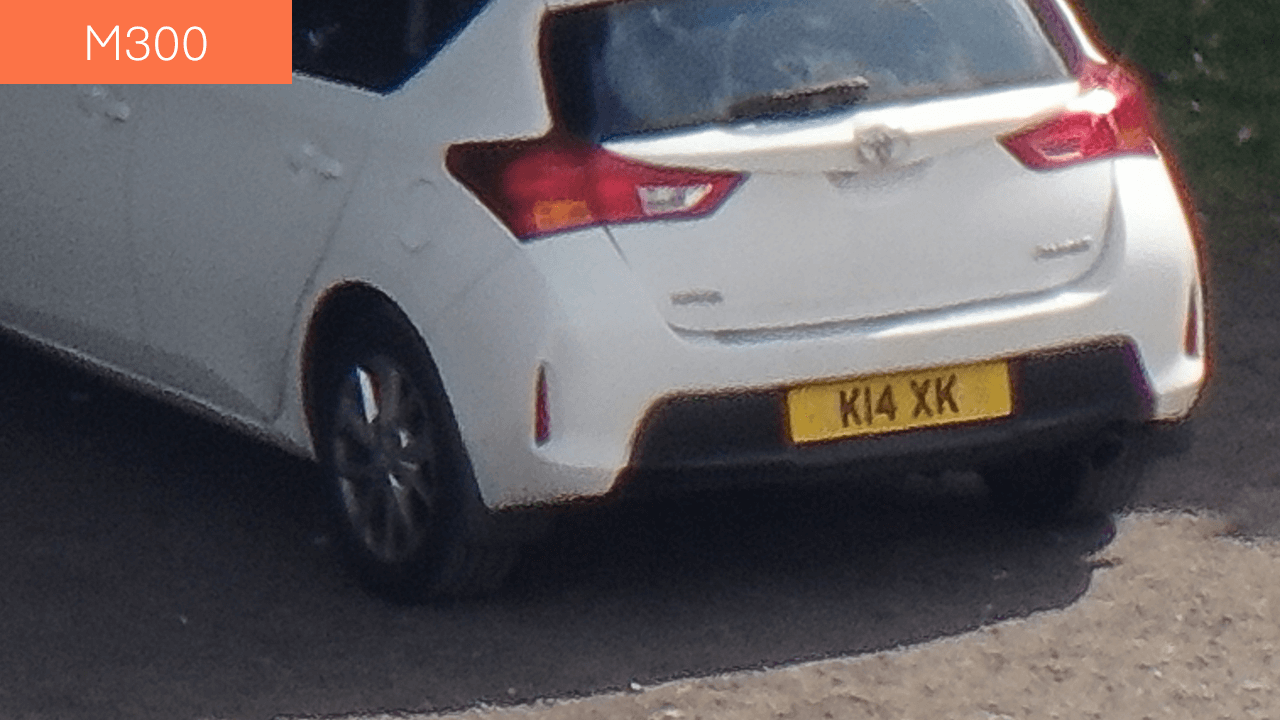
300m Away, 200x max zoom: M30T and M300 RTK
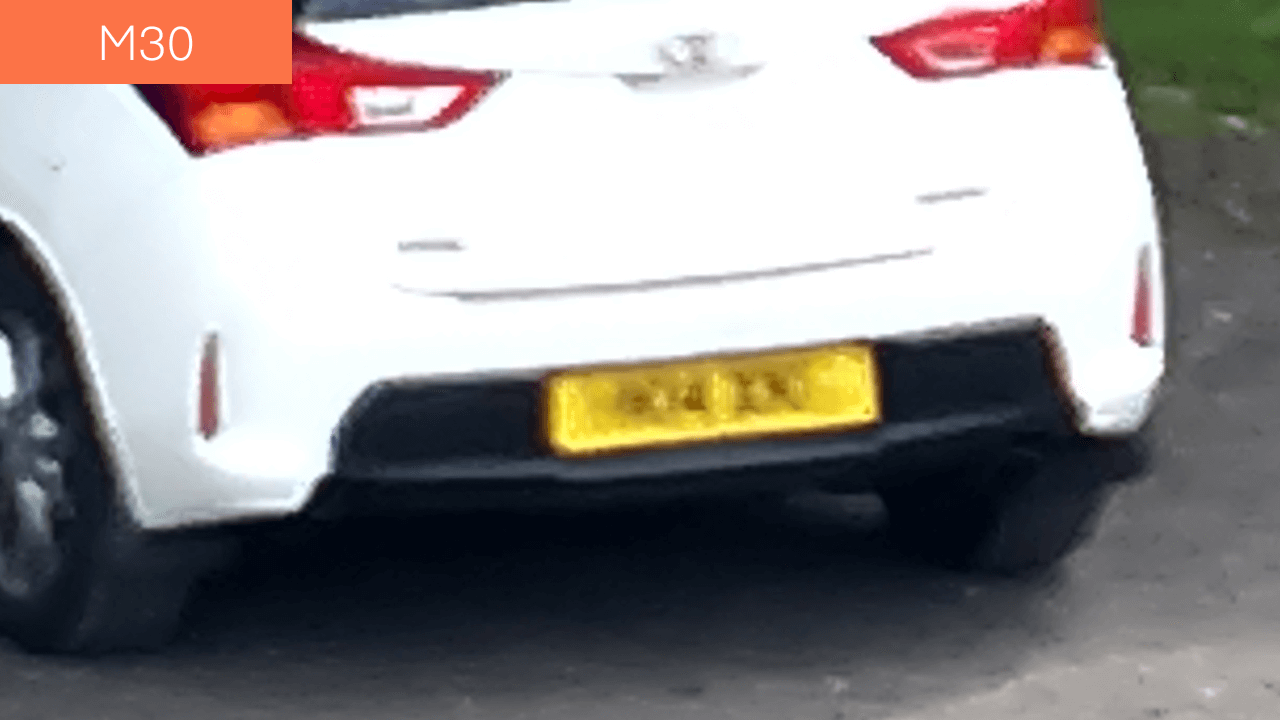
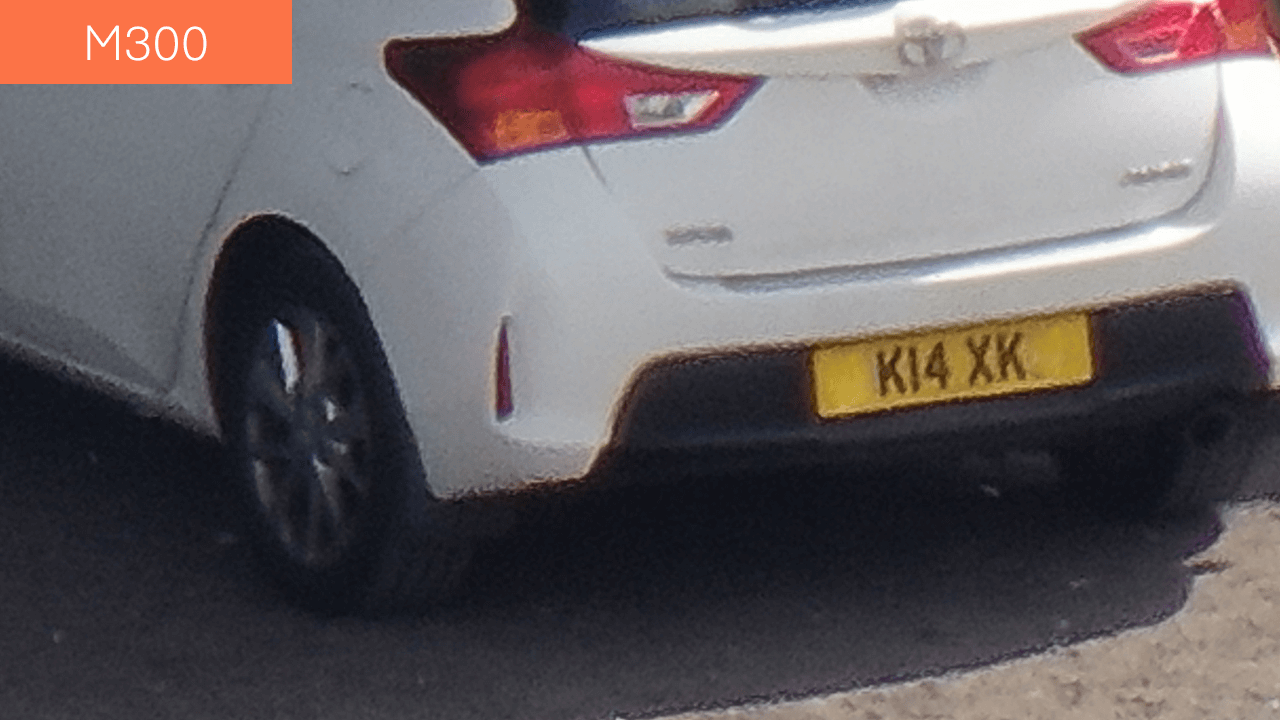
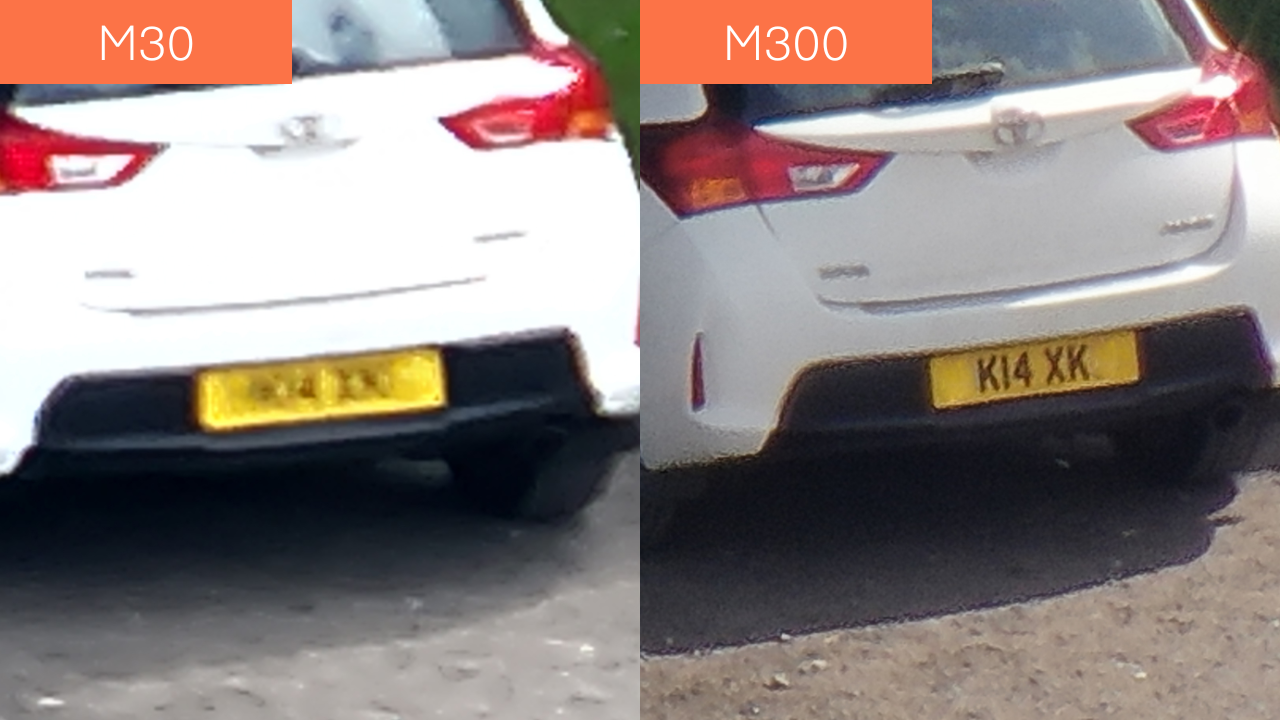
400m Away From The Subject
To further test the strength of the M300 RTK and H20T, we took the aircraft to 400m away from the vehicle, remaining at 60m above the surface...

...and the camera still coped with the distance, obtaining this view with 80x zoom...
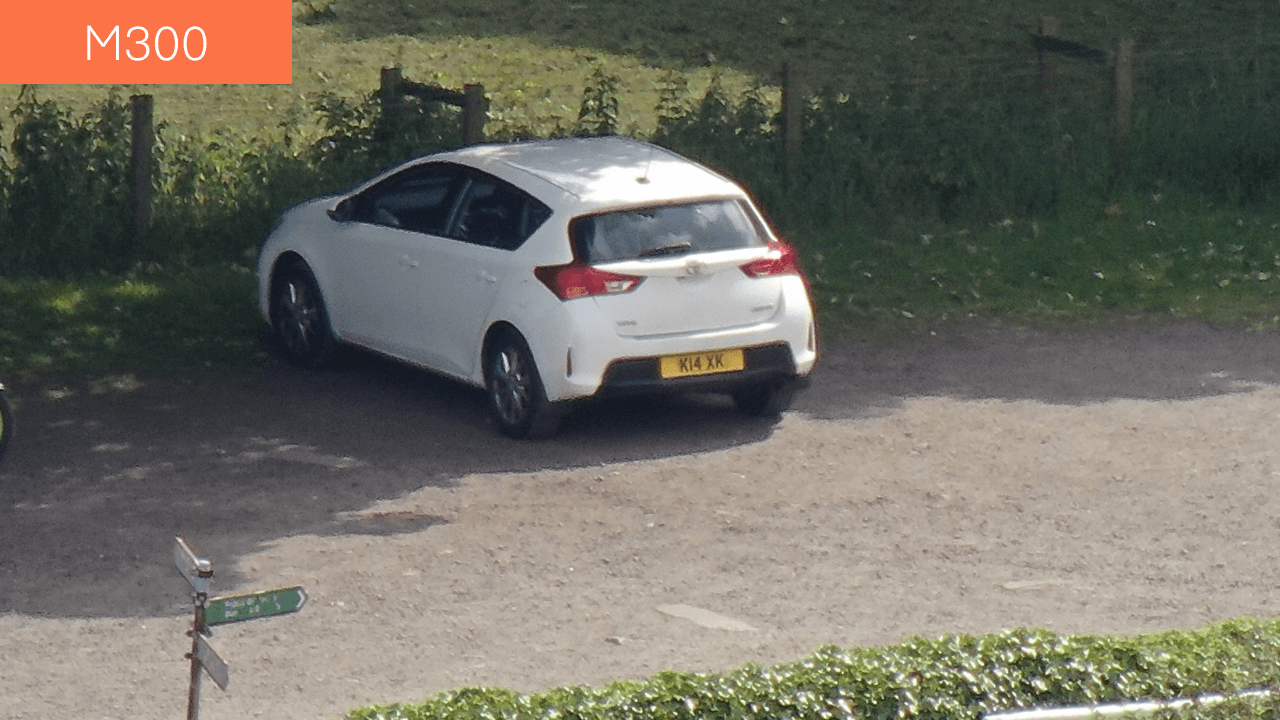
...and also 200x max zoom.
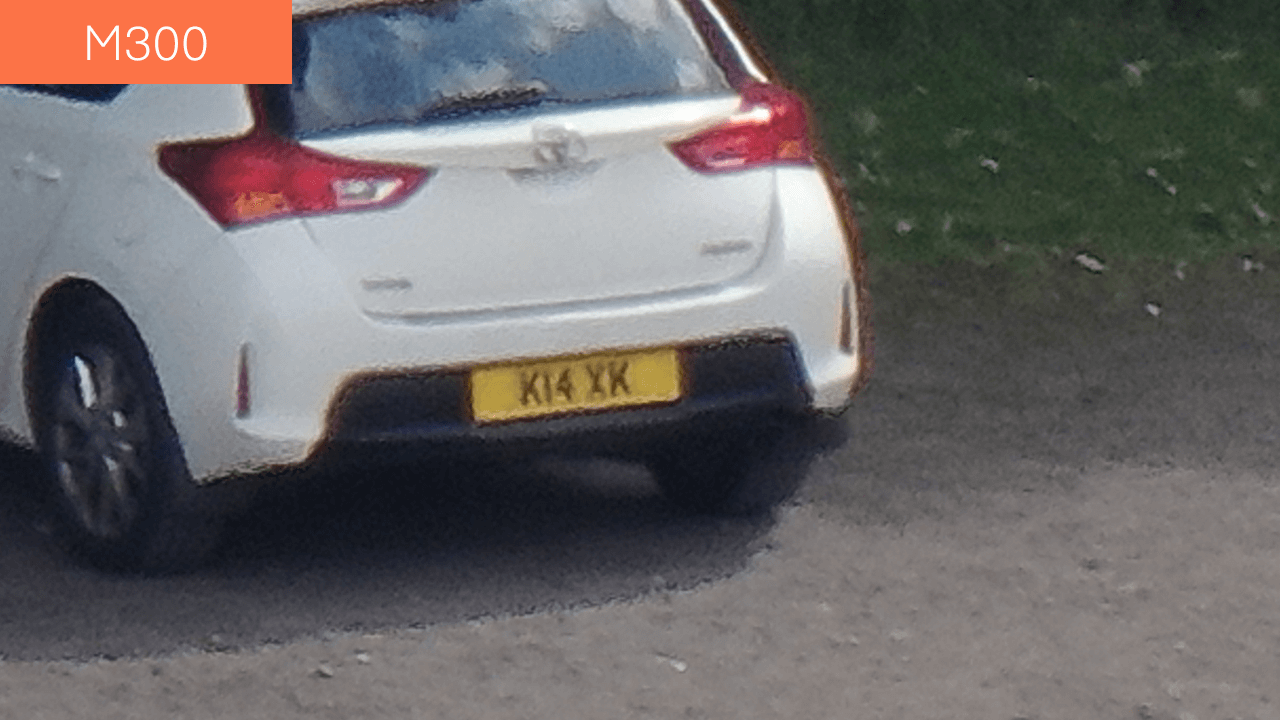
DJI M30 Vs M300 RTK and H20T: Summary And Conclusion
So, what did we learn?
It's fair to say that both drones do a very good job at providing visual data.
For instance, this image collected during the powerline test, showing the M30T's 16x optical zoom from 20m away, is super sharp and provides a great level of detail...

...even when cropping in on the image.
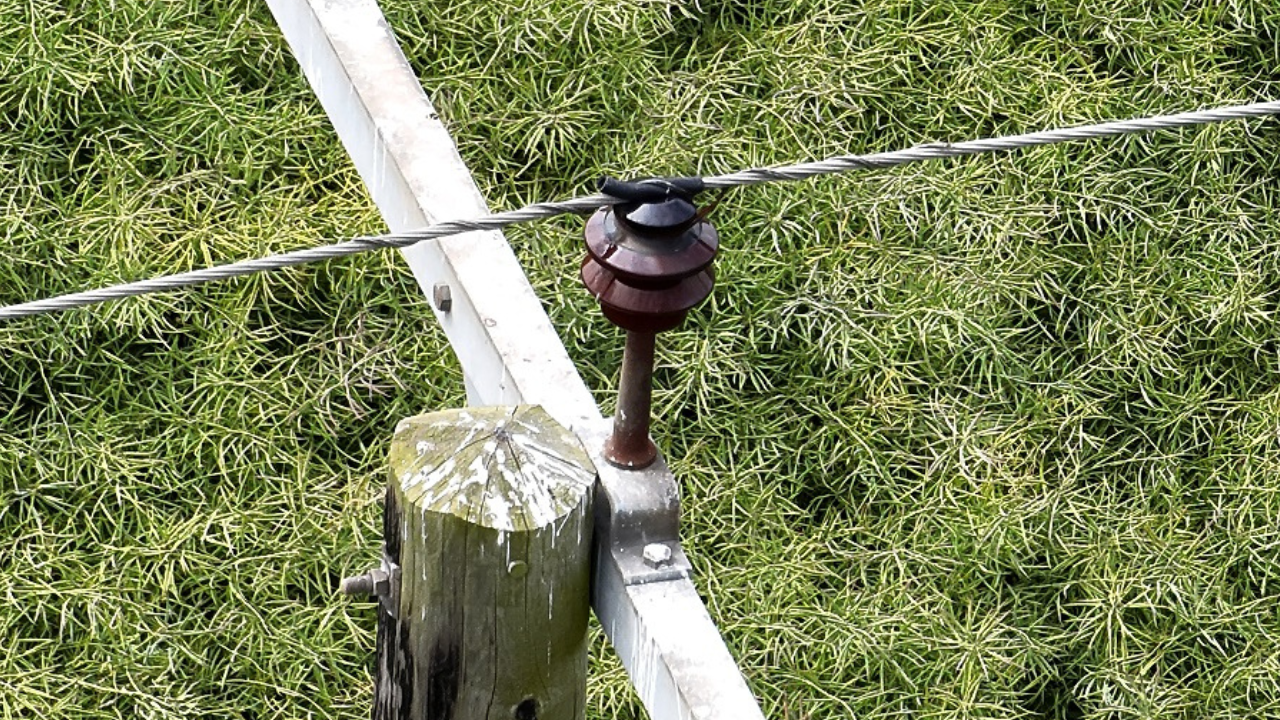
The same can also be said of the M300 RTK: This image from 20m away at 80x zoom yields incredible detail.

However, from our data sets, the H20T appears to have the edge, especially at increased distances, as this image demonstrates - showcasing each camera's 160x zoom at 80m from the powerline.
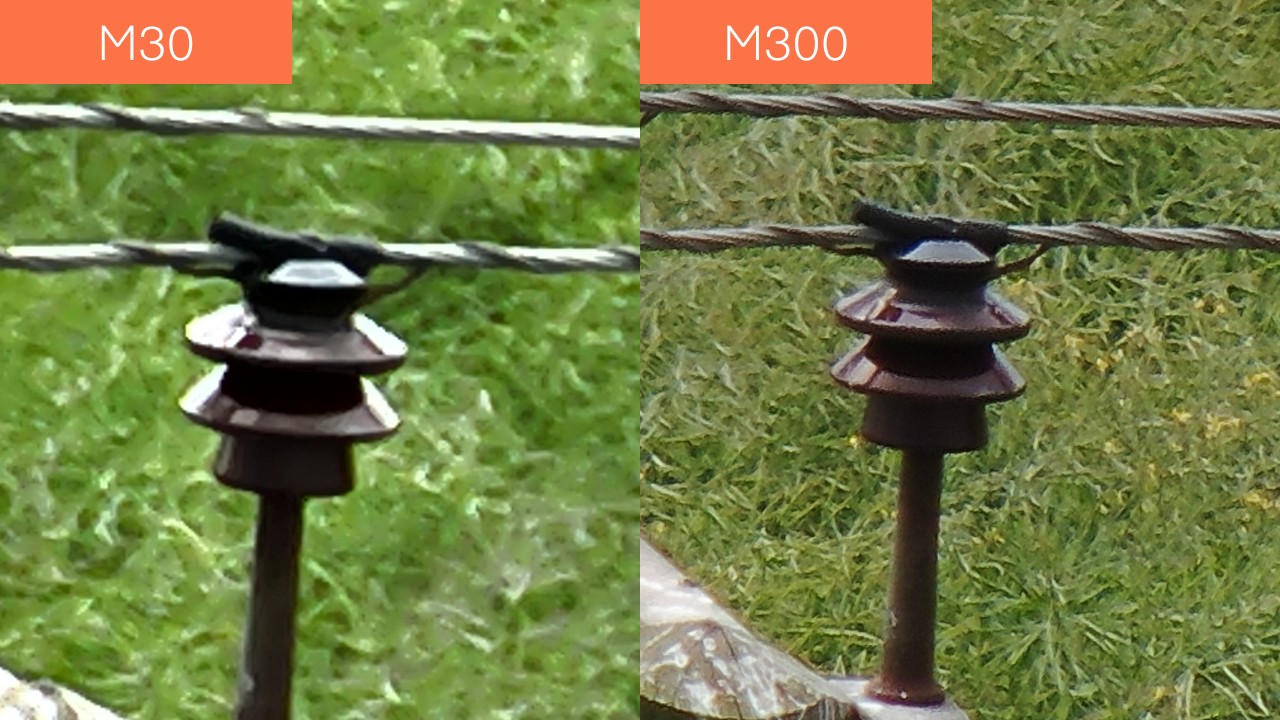
It has to be said though, it is highly unlikely that an M30 Series drone would be used to conduct a visual inspection from such large distances, therefore its high quality imagery at closer range is perhaps a more reasonable barometer. But even though its imagery from afar is not quite on par with the H20T, it is still good enough to obtain certain types of visual information for inspection.
On the other side of the coin, the tests do confirm the incredible capabilities of the H20T: Its ability further endorsed by the number plate test, yielding crystal clear imagery from 400ft!
Seemingly, the H20T's larger sensor size (wide: H20T 1/2.3-inch vs M30T 1/2-inch; and zoom: H20T 1/1.7-inch vs M30T 1/2-inch) has a major role to play here. And let's face it: The H20T alone is almost the same price as the M30T, so its additional quality to not surprising.
As for the thermal, both drones returned good results. We were suitably impressed with the M30T's capabilities in the search and rescue scenario, both from an infrared and visual point of view.
With its enhanced IP rating, reduced size and lightweight nature, we feel that the M30 Series is especially suited to public safety/search and rescue missions, so the fact it performed well in this situation was pleasing.
On the size front, the picture below shows the difference in footprint between the two platforms (and also the Mavic 2 Enterprise Advanced). It highlights just how much smaller the M30 Series is compared to the M300 RTK.
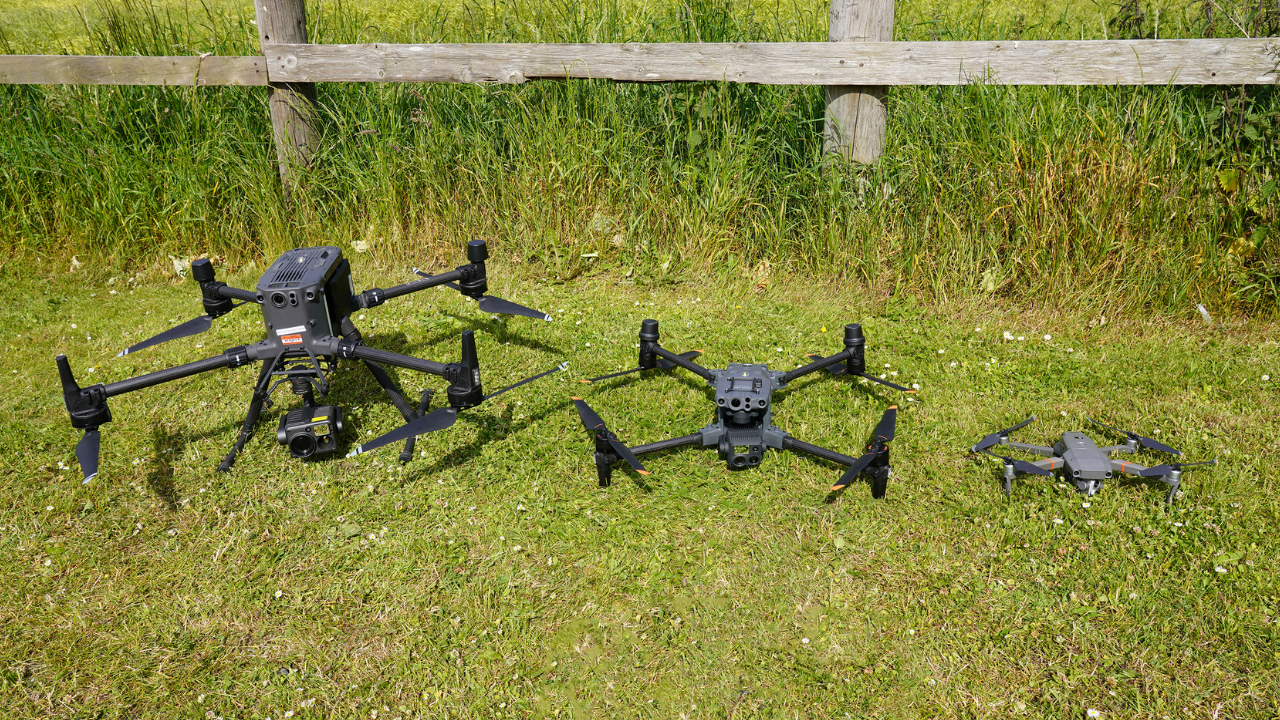
Also, check out the difference in the size of the cases. We pulled both from our vehicle to the flight area and it was far easier to transport the M30T in its box compared to the M300 RTK - which is another consideration, especially for public safety, search and rescue and other missions which involve traversing difficult terrain.
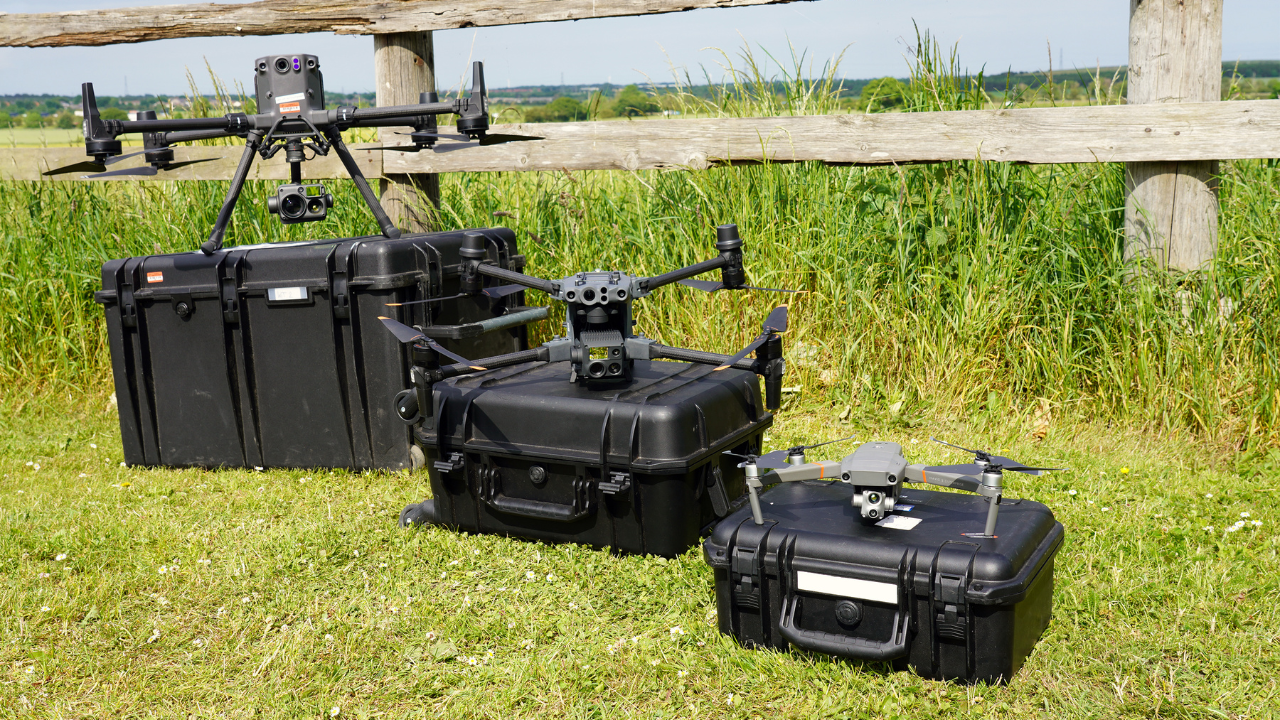
As a side note, the M300 RTK above is not in its standard box - rather a larger HPRC case - but a typical M300 case still has a substantial footprint compared to the M30 Series' box.
When comparing the two platforms, it is also important to factor in the prices between them. An M30T is in the region of £11,000, while the H20T alone is £10,200, with the M300 RTK an additional £10,450.
With this in mind, the choice between the M30 Series and M300 RTK-H20T essentially boils down to the specific type of use case and budget.
The M30 Series is an extremely capable drone - with a great balance of power, portability, performance and price.
But the M300 RTK is a stellar aircraft and when it comes to performance, it remains the crown jewel in DJI's enterprise fleet. Its capabilities with the H20T are clear to see from our tests, and the fact that it can be integrated with a range of other payloads, including the P1 and L1 mapping sensors, is a huge bonus.
But also consider this: Don't necessarily think of it as a direct choice between one or the other. With both drones having their own distinct advantages and disadvantages, some drone programmes will benefit from having both of these powerful aircraft in their fleet and using them on a case by case basis.
Contact the heliguy™ enterprise team to discuss the M300 RTK, H20T, and M30 Series and find out how you can use them to start or scale your drone fleet.
